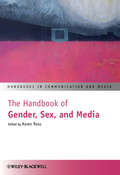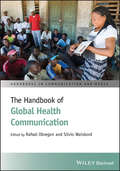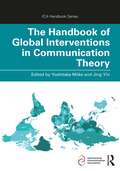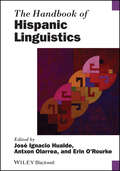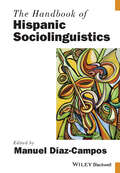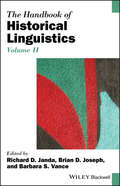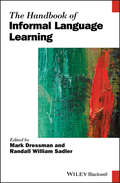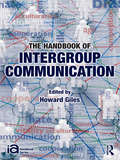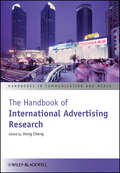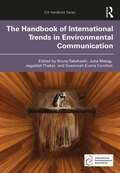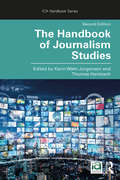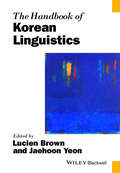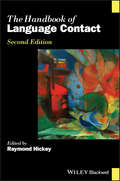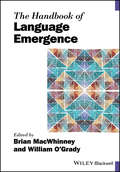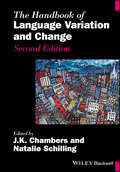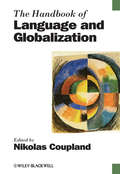- Table View
- List View
The Handbook of Financial Communication and Investor Relations
by Alexander V. LaskinThe first book to offer a global look at the state-of-the-art thinking and practice in investor relations and financial communication Featuring contributions from leading scholars and practitioners in financial communication and related fields--including public relations, corporate communications, finance, and accounting-- this volume in the critically acclaimed "Handbooks in Communication and Media" seriesprovides readers with a comprehensive, up-to-date picture of investor relations and financial communications as they are practiced in North America and around the world. The Handbook of Financial Communication and Investor Relations provides an overview of the past, present, and future of investor relations and financial communications as a profession. It identifies the central issues of contemporary investor relations and financial communications practice, including financial information versus non-financial information, intangibles, risk, value, and growth. Authors address key topics of concern to contemporary practitioners, such as socially responsible investing, corporate governance, shareholder activism, ethics, and professionalism. In addition, the book arms readers with metrics and proven techniques for reliably measuring and evaluating the effectiveness of investor relations and financial communications. Bringing together the most up-to-date research on investor relations and financial communication and the insights and expertise of an all-star team of practitioners, The Handbook of Financial Communication and Investor Relations: Explores how the profession is practiced in various regions of the globe, including North America, South America, Europe, the Middle East, India, Australia, and other areas Provides a unique look at financial communication as it is practiced beyond the corporate world, including in families, the medical profession, government, and the not-for-profit sector Addresses "big-picture" strategies as well as specific tactics for financial communication during crises, the use of social media, dealing with shareholder activism, integrated reporting and CSR, and more This book makes an ideal reference resource for undergrads and graduate students, scholars, and practitioners studying or researching investor relations and financial communication across schools of communication, journalism, business, and management. It also offers professionals an up-to-date, uniquely holistic look at best practices in financial communication investor relations worldwide.
The Handbook of Gender, Sex, and Media (Handbooks in Communication and Media #24)
by Karen RossThe Handbook of Gender, Sex and Media offers original insights into the complex set of relations which exist between gender, sex, sexualities and the media, and in doing so, showcases new research at the forefront of media and communication practice and theory. Brings together a collection of new, cutting-edge research exploring a number of different facets of the broad relationship between gender and media Moves beyond associating gender with man/woman and instead considers the relationship between the construction of gender norms, biological sex and the mediation of sex and sexuality Offers genuinely new insights into the complicated and complex set of relations which exist between gender, sex, sexualities and the media Essay topics range from the continuing sexism of TV advertising to ways in which the internet is facilitating the (re)invention of our sexual selves.
The Handbook of Global Health Communication (Handbooks in Communication and Media #29)
by Silvio Waisbord Rafael ObregonInternational in scope, The Handbook of Global Health Communication offers a comprehensive and up-to-date analysis of the role of communication processes in global public health, development and social change Brings together 32 contributions from well-respected scholars and practitioners in the field, addressing a wide range of communication approaches in current global health programs Offers an integrated view that links communication to the strengthening of health services, the involvement of affected communities in shaping health policies and improving care, and the empowerment of citizens in making decisions about health Adopts a broad understanding of communication that goes beyond conventional divisions between informational and participatory approaches
The Handbook of Global Interventions in Communication Theory (ICA Handbook Series)
by Yoshitaka MiikeMoving beyond the U.S.-Eurocentric paradigm of communication theory, this handbook broadens the intellectual horizons of the discipline by highlighting underrepresented, especially non-Western, theorists and theories, and identifies key issues and challenges for future scholarship. Showcasing diverse perspectives, the handbook facilitates active engagement in different cultural traditions and theoretical orientations that are global in scope but local in effect. It begins by exploring past efforts to diversify the field, continuing on to examine theoretical concepts, models, and principles rooted in local cumulative wisdom. It does not limit itself to the mass-interpersonal communication divide, but rather seeks to frame theory as global and inclusive in scope. The book is intended for communication researchers and advanced students, with relevance to scholars with an interest in theory within information science, library science, social and cross-cultural psychology, multicultural education, social justice and social ethics, international relations, development studies, and political science.
The Handbook of Hispanic Linguistics (Blackwell Handbooks in Linguistics #93)
by José Ignacio Hualde Antxon Olarrea Erin O'RourkeReflecting the growth and increasing global importance of the Spanish language, The Handbook of Hispanic Linguistics brings together a team of renowned Spanish linguistics scholars to explore both applied and theoretical work in this field. Features 41 newly-written essays contributed by leading language scholars that shed new light on the growth and significance of the Spanish language Combines current applied and theoretical research results in the field of Spanish linguistics Explores all facets relating to the origins, evolution, and geographical variations of the Spanish language Examines topics including second language learning, Spanish in the classroom, immigration, heritage languages, and bilingualism
The Handbook of Hispanic Sociolinguistics
by Manuel Diaz-CamposThis Handbook provides a comprehensive, state-of-the-art overview of theoretical and descriptive research in contemporary Hispanic sociolinguistics.Offers the first authoritative collection exploring research strands in the emerging and fast-moving field of Spanish sociolinguisticsHighlights the contributions that Spanish Sociolinguistics has offered to general linguistic theoryBrings together a team of the top researchers in the field to present the very latest perspectives and discussions of key issuesCovers a wealth of topics including: variationist approaches, Spanish and its importance in the U.S., language planning, and other topics focused on the social aspects of SpanishIncludes several varieties of Spanish, reflecting the rich diversity of dialects spoken in the Americas and Spain
The Handbook of Historical Linguistics, Volume II (Blackwell Handbooks in Linguistics)
by Brian D. Joseph Richard D. Janda Barbara S. VanceAn entirely new follow-up volume providing a detailed account of numerous additional issues, methods, and results that characterize current work in historical linguistics. This brand-new, second volume of The Handbook of Historical Linguistics is a complement to the well-established first volume first published in 2003. It includes extended content allowing uniquely comprehensive coverage of the study of language(s) over time. Though it adds fresh perspectives on several topics previously treated in the first volume, this Handbook focuses on extensions of diachronic linguistics beyond those key issues. This Handbook provides readers with studies of language change whose perspectives range from comparisons of large open vs. small closed corpora, via creolistics and linguistic contact in general, to obsolescence and endangerment of languages. Written by leading scholars in their respective fields, new chapters are offered on matters such as the origin of language, evidence from language for reconstructing human prehistory, invocations of language present in studies of language past, benefits of linguistic fieldwork for historical investigation, ways in which not only biological evolution but also field biology can serve as heuristics for research into the rise and spread of linguistic innovations, and more. Moreover, it: offers novel and broadened content complementing the earlier volume so as to provide the fullest available overview of a wholly engrossing field includes 23 all-new contributed chapters, treating some familiar themes from fresh perspectives but mostly covering entirely new topics features expanded discussion of material from language families other than Indo-European provides a multiplicity of views from numerous specialists in linguistic diachrony. The Handbook of Historical Linguistics, Volume II is an ideal book for undergraduate and graduate students in linguistics, researchers and professional linguists, as well as all those interested in the history of particular languages and the history of language more generally.
The Handbook of Historical Sociolinguistics
by Juan Camilo Conde-Silvestre Juan Manuel Hernández-CampoyWritten by an international team of leading scholars, this groundbreaking reference work explores the nature of language change and diffusion, and paves the way for future research in this rapidly expanding interdisciplinary field.Features 35 newly-written essays from internationally acclaimed experts that reflect the growth and vitality of the burgeoning area of historical sociolinguisticsExamines how sociolinguistic theoretical models, methods, findings, and expertise can be used to reconstruct a language's past in order to explain linguistic changes and developmentsBridges the gap between the past and the present in linguistic studiesStructured thematically into sections exploring: origins and theoretical assumptions; methods for the sociolinguistic study of the history of languages; linguistic and extra-linguistic variables; historical dialectology, language contact and diffusion; and attitudes to language
The Handbook of Informal Language Learning (Blackwell Handbooks in Linguistics)
by Mark Dressman Randall William SadlerProvides a comprehensive and unique examination of global language learning outside of the formal school setting Authored by a prominent team of international experts in their respective fields, The Handbook of Informal Language Learning is a one-of-a-kind reference work and it is a timely and valuable resource for anyone looking to explore informal language learning outside of a formal education environment. It features a comprehensive collection of cutting edge research areas exploring the cultural and historical cases of informal language learning, along with the growing area of digital language learning, and the future of this relevant field in national development and language education. The Handbook of Informal Language Learning examines informal language learning from both theoretical and practical perspectives. Structured across six sections, chapters cover areas of motivation, linguistics, cognition, and multimodality; digital learning, including virtual contexts, gaming, fanfiction, vlogging, mobile devices, and nonformal programs; and media and live contact, including learning through environmental print, tourism/study abroad. The book also provides studies of informal learning in four national contexts, examines the integration of informal and formal classroom learning, and discusses the future of language learning from different perspectives. Edited by respected researchers of computer-mediated communication and second language learning and teacher education Features contributions by leading international scholars reaching out to a global audience Presents an exciting and progressive selection of chapters in a rapidly expanding field of research and teaching Provides a state-of-the-art collection of the theories, as well as the historical, cultural and international cases relating to informal language learning and its future in a digital age Covers 30 key topics that represent pioneering findings and new research The Handbook of Informal Language Learning is an essential resource for researchers, students, and professionals in the fields of language acquisition, English as a second language, and foreign language education.
The Handbook of Intercultural Discourse and Communication (Blackwell Handbooks in Linguistics #90)
by Elizabeth S. Rangel Scott F. Kiesling Christina Bratt PaulstonThe Handbook of Intercultural Discourse and Communication brings together internationally-renowned scholars from a range of fields to survey the theoretical perspectives and applied work, including example analyses, in this burgeoning area of linguistics. Features contributions from established researchers in sociolinguistics and intercultural discourse Explores the theoretical perspectives underlying work in the field Examines the history of the field, work in cross-cultural communication, and features of discourse Establishes the scope of this interdisciplinary field of study Includes coverage on individual linguistic features, such as indirectness and politeness, as well as sample analyses of IDC exchanges
The Handbook of Intergroup Communication (ICA Handbook Series)
by Michael Hogg Howard Giles Miles Hewstone Jake Harwood Cynthia Gallois Scott A. Reid John C. TurnerThe Handbook of Intergroup Communication brings together research, theory and application on traditional as well as innovative intergroup situations, exploring the communication aspect of these groups. The volume is organized into four domains – cross-disciplinary approaches to intergroup study; types/processes of communication between groups; communication between specific group types; and arenas in which intergroup communication takes place. Editor Howard Giles worked with an internationally-based advisory board to develop and review content, and the contributors included here represent those scholars doing innovative and well-regarded work around the globe. The "intergroup" umbrella integrates and transcends many traditional conceptual boundaries in communication (including media, health, intercultural, organizational); hence the Handbook will appeal to scholars and graduate students not only in the core area of intergroup communication itself, but across varying terrains of study in communication and beyond, including intergroup relations and social psychology.
The Handbook of International Advertising Research (Handbooks in Communication and Media)
by Hong ChengThis timely handbook brings academic excellence to international advertising research in the form of 28 contributions from over 40 leading scholars. The handbook’s comprehensive treatment highlights existing knowledge, reports major findings across the subject, and recommends directions and agendas for future research. Fills the existing gap between the rapid growth in scholarly research on international advertising and the pressing need for more high-quality research in the area Covers 28 major areas in international advertising research, with contributions from more than 40 international advertising scholars based in over 10 countries or territories Comprehensive treatment includes the history of international advertising, audiences and media, strategy and execution, content effects, regulation, ethics, and advertising education Highlights existing knowledge in international advertising, reports major findings on a broad range of topics, and offers expert recommendations on directions for future research Contributors represent the most highly respected academics among international advertising researchers
The Handbook of International Trends in Environmental Communication (ICA Handbook Series)
by Bruno TakahashiThis handbook provides a comprehensive review of communication around rising global environmental challenges and public action to manage them now and into the future. Bringing together theoretical, methodological, and practical chapters, this book presents a unique opportunity for environmental communication scholars to critically reflect on the past, examine present trends, and start envisioning exciting new methodologies, theories, and areas of research. Chapters feature authors from a wide range of countries to critically review the genesis and evolution of environmental communication research and thus analyze current issues in the field from a truly international perspective, incorporating diverse epistemological perspectives, exciting new methodologies, and interdisciplinary theoretical frameworks. The handbook seeks to challenge existing dominant perspectives of environmental communication from and about populations in the Global South and disenfranchised populations in the Global North. The Handbook of International Trends in Environmental Communication is ideal for scholars and advanced students of communication, sustainability, strategic communication, media, environmental studies, and politics.
The Handbook of International Trends in Environmental Communication (ICA Handbook Series)
by Bruno TakahashiThis handbook provides a comprehensive review of communication around rising global environmental challenges and public action to manage them now and into the future. Bringing together theoretical, methodological, and practical chapters, this book presents a unique opportunity for environmental communication scholars to critically reflect on the past, examine present trends, and start envisioning exciting new methodologies, theories, and areas of research. Chapters feature authors from a wide range of countries to critically review the genesis and evolution of environmental communication research and thus analyze current issues in the field from a truly international perspective, incorporating diverse epistemological perspectives, exciting new methodologies, and interdisciplinary theoretical frameworks. The handbook seeks to challenge existing dominant perspectives of environmental communication from and about populations in the Global South and disenfranchised populations in the Global North.The Handbook of International Trends in Environmental Communication is ideal for scholars and advanced students of communication, sustainability, strategic communication, media, environmental studies, and politics.
The Handbook of Journal Publishing
by Margaret Reich Sally Morris Ed Barnas Douglas LafrenierThe Handbook of Journal Publishing is a comprehensive reference work written by experienced professionals, covering all aspects of journal publishing, both online and in print. Journals are crucial to scholarly communication, but changes in recent years in the way journals are produced, financed, and used make this an especially turbulent and challenging time for journal publishers - and for authors, readers, and librarians. The Handbook offers a thorough guide to the journal publishing process, from editing and production through marketing, sales, and fulfilment, with chapters on management, finances, metrics, copyright, and ethical issues. It provides a wealth of practical tools, including checklists, sample documents, worked examples, alternative scenarios, and extensive lists of resources, which readers can use in their day-to-day work. Between them, the authors have been involved in every aspect of journal publishing over several decades and bring to the text their experience working for a wide range of publishers in both the not-for-profit and commercial sectors.
The Handbook of Journalism Studies (ICA Handbook Series)
by Karin Wahl-Jorgensen Thomas HanitzschThis second edition of The Handbook of Journalism Studies explores the current state of research in journalism studies and sets an agenda for future development of the field in an international context. The volume is structured around theoretical and empirical approaches to journalism research and covers scholarship on news production; news content; journalism and society; journalism and culture; and journalism studies in a global context. As journalism studies has become richer and more diverse as a field of study, the second edition reflects both the growing diversity of the field, and the ways in which journalism itself has undergone rapid change in recent years. Emphasizing comparative and global perspectives, this new edition explores: Key elements, thinkers, and texts Historical context Current state of the field Methodological issues Merits and advantages of the approach/area of study Limitations and critical issues of the approach/area of study Directions for future research Offering broad international coverage from world-leading contributors, this volume is a comprehensive resource for theory and scholarship in journalism studies. As such, it is a must-have resource for scholars and graduate students working in journalism, media studies, and communication around the globe.
The Handbook of Korean Linguistics (Blackwell Handbooks in Linguistics)
by Jaehoon Yeon Lucien BrownThe Handbook of Korean Linguistics presents state-of-the-art overviews of the linguistic research on the Korean language. • Structured to allow a range of theoretical perspectives in addressing linguistic phenomena • Includes chapters on Old Korean and Middle Korean, present-day language policies in North and South Korea, social aspects of Korean as a heritage language, and honorifics • Indispensable and unique resource not only for those studying Korean linguistics but cross-linguistic research in general
The Handbook of Language Contact
by Raymond HickeyThe Handbook of Language Contact offers systematic coverage of the major issues in this field - ranging from the value of contact explanations in linguistics, to the impact of immigration, to dialectology - combining new research from a team of globally renowned scholars, with case studies of numerous languages.An authoritative reference work exploring the major issues in the field of language contact: the study of how language changes when speakers of distinct speech varieties interactBrings together 40 specially-commissioned essays by an international team of scholarsExamines language contact in societies which have significant immigration populations, and includes a fascinating cross-section of case studies drawing on languages across the worldAccessibly structured into sections exploring the place of contact studies within linguistics as a whole; the value of contact studies for research into language change; and language contact in the context of work on language and societyExplores a broad range of topics, making it an excellent resource for both faculty and students across a variety of fields within linguistics
The Handbook of Language Contact (Blackwell Handbooks in Linguistics)
by Raymond HickeyThe second edition of the definitive reference on contact studies and linguistic change—provides extensive new research and original case studies Language contact is a dynamic area of contemporary linguistic research that studies how language changes when speakers of different languages interact. Accessibly structured into three sections, The Handbook of Language Contact explores the role of contact studies within the field of linguistics, the value of contact studies for language change research, and the relevance of language contact for sociolinguistics. This authoritative volume presents original findings and fresh research directions from an international team of prominent experts. Thirty-seven specially-commissioned chapters cover a broad range of topics and case studies of contact from around the world. Now in its second edition, this valuable reference has been extensively updated with new chapters on topics including globalization, language acquisition, creolization, code-switching, and genetic classification. Fresh case studies examine Romance, Indo-European, African, Mayan, and many other languages in both the past and the present. Addressing the major issues in the field of language contact studies, this volume: Includes a representative sample of individual studies which re-evaluate the role of language contact in the broader context of language and society Offers 23 new chapters written by leading scholars Examines language contact in different societies, including many in Africa and Asia Provides a cross-section of case studies drawing on languages across the world The Handbook of Language Contact, Second Edition is an indispensable resource for researchers, scholars, and students involved in language contact, language variation and change, sociolinguistics, bilingualism, and language theory.
The Handbook of Language Emergence (Blackwell Handbooks in Linguistics #88)
by William O'Grady Brian MacWhinneyThis authoritative handbook explores the latest integrated theory for understanding human language, offering the most inclusive text yet published on the rapidly evolving emergentist paradigm. Brings together an international team of contributors, including the most prominent advocates of linguistic emergentism Focuses on the ways in which the learning, processing, and structure of language emerge from a competing set of cognitive, communicative, and biological constraints Examines forces on widely divergent timescales, from instantaneous neurolinguistic processing to historical changes and language evolution Addresses key theoretical, empirical, and methodological issues, making this handbook the most rigorous examination of emergentist linguistic theory ever
The Handbook of Language Teaching (Blackwell Handbooks in Linguistics #65)
by Catherine J. Doughty Michael H. LongBringing together an international and interdisciplinary team of contributors, this Handbook is a wide-ranging and invaluable reference guide to language teaching. A comprehensive reference work on language teaching, which combines the latest research findings, coverage of core topics, and examples of teaching experience from a variety of languages and settings Provides a unique breadth of coverage, including: the psycholinguistic underpinnings of language learning; social, political, and educational contexts; program design; materials writing and course design; teaching and testing; teacher education; and assessment and evaluation Offers a balanced evaluation of the major positions and approaches, including examining the increasingly important social and political context of language teaching Written by an international and interdisciplinary group of authors from a dozen different countries; English is only one of the many languages used as examples throughout the volume
The Handbook of Language Variation and Change (Blackwell Handbooks in Linguistics #129)
by Natalie Schilling J. K. ChambersReflecting a multitude of developments in the study of language change and variation over the last ten years, this extensively updated second edition features a number of new chapters and remains the authoritative reference volume on a core research area in linguistics. A fully revised and expanded edition of this acclaimed reference work, which has established its reputation based on its unrivalled scope and depth of analysis in this interdisciplinary field Includes seven new chapters, while the remainder have undergone thorough revision and updating to incorporate the latest research and reflect numerous developments in the field Accessibly structured by theme, covering topics including data collection and evaluation, linguistic structure, language and time, language contact, language domains, and social differentiation Brings together an experienced, international editorial and contributor team to provides an unrivalled learning, teaching and reference tool for researchers and students in sociolinguistics
The Handbook of Language and Globalization (Blackwell Handbooks in Linguistics #64)
by Nikolas CouplandThe Handbook of Language and Globalization brings together important new studies of language and discourse in the global era, consolidating a vibrant new field of sociolinguistic research. The first volume to assemble leading scholarship in this rapidly developing field Features new contributions from 36 internationally-known scholars, bringing together key research in the field and establishing a benchmark for future research Comprehensive coverage is divided into four sections: global multilingualism, world languages and language systems; global discourse in key domains and genres; language, values and markets under globalization; and language, distance and identities Covers an impressive breadth of topics including tourism, language teaching, social networking, terrorism, and religion, among many others Winner of the British Association for Applied Linguistics book prize 2011
The Handbook of Language and Speech Disorders (Blackwell Handbooks In Linguistics Ser.)
by Nicole MullerThe Handbook of Speech and Language Disorders presents a comprehensive survey of the latest research in communication disorders. Contributions from leading experts explore current issues, landmark studies, and the main topics in the field, and include relevant information on analytical methods and assessment. A series of foundational chapters covers a variety of important general principles irrespective of specific disorders. These chapters focus on such topics as classification, diversity considerations, intelligibility, the impact of genetic syndromes, and principles of assessment and intervention. Other chapters cover a wide range of language, speech, and cognitive/intellectual disorders.
The Handbook of Language and Speech Disorders (Blackwell Handbooks in Linguistics #49)
by Martin J. Ball Jack S. Damico Nicole M LlerAn authoritative overview of language and speech disorders, featuring new and updated chapters written by leading specialists from across the field The Handbook of Speech and Language Disorders, Second Edition, provides timely and authoritative coverage of current issues, foundational principles, and new research directions within the study of communication disorders. Building upon the reputation of the landmark first edition, this volume offers an exceptionally broad and in-depth survey of the field, presenting original chapters by internationally recognized specialists that examine an array of language, speech, and cognitive disorders and discuss the most crucial aspects of this evolving discipline while providing practical information on analytical methods and assessment. Now in its second edition, the Handbook features extensively revised and refocused content throughout, reflecting the latest advances in the field. Original and updated chapters explore diverse topics including literacy and literacy impairments, patterns of normal and disordered language development, hearing impairment and cochlear implants, language acquisition and language delay, dementia, dysarthria, ADHD, autism spectrum disorder, and many others. This acclaimed single-volume reference resource: Provides 26 original chapters which describe the latest in new research and which indicate future research directions Covers new developments in research since the original publication of the first edition Features in-depth coverage of the major disorders of language and speech, including new insights on perception, hearing impairment, literacy, and genetic syndromes Includes a series of foundational chapters covering a variety of important general principles, including labelling, diversity, intelligibility, assessment, and intervention The Handbook of Speech and Language Disorders, Second Edition, is essential reading for researchers, scholars, and students in speech and language pathology, speech, language and hearing sciences, and clinical llinguistics, as well as active practitioners and clinicians.

